Garden Glimpses: June 2022 – We’re Gettin’ There!
It’s been a cool spring, and as summer commences, that trend has largely continued. So the garden is a good 2-3 weeks behind where it was at this time last year. But on the upside, rainfall has been steady and regular, so everything is looking very lush, without any backbreaking effort on my part. Just how we like it!
Before we go any further, I feel the need to correct some statements made in prior “Garden Glimpses” columns. I have always been told, and have been repeating, that oakleaf hydrangeas bloom on old wood. So you may remember my sadness and annoyance that no flower buds were visible on any of my oakleafs this spring, which I assumed meant no blooms for 2022.
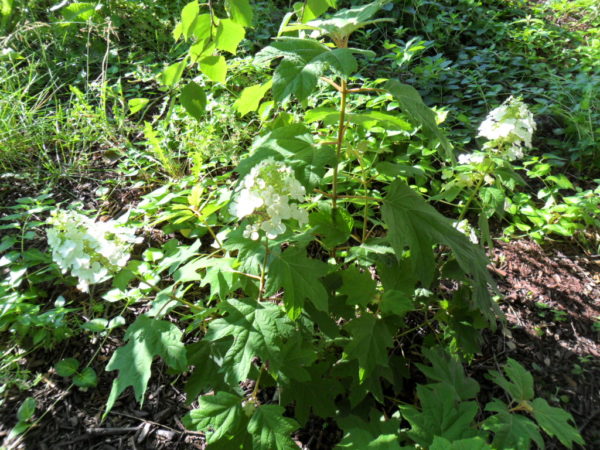
But not so! As May deepened toward June, I observed the emergence of flower buds, first on Pee Wee, a dwarf variety which was the only oakleaf to offer blooms in its first year, 2021. Then Snowflake weighed in, and even Queen of Hearts, seriously damaged by a heavy snowfall last winter, offered me a solitary blossom. Alice was the only country not heard from, but just this week I saw a bud beginning to unfurl, at the tip of at least 12 inches of soft, pliable new cinnamon-brown stem. If that’s “blooming on old wood,” then I guess I need a redefinition, because either I don’t understand the term, or I’ve been lied to my whole life!
Still, all’s well that ends well, as these photos will attest.
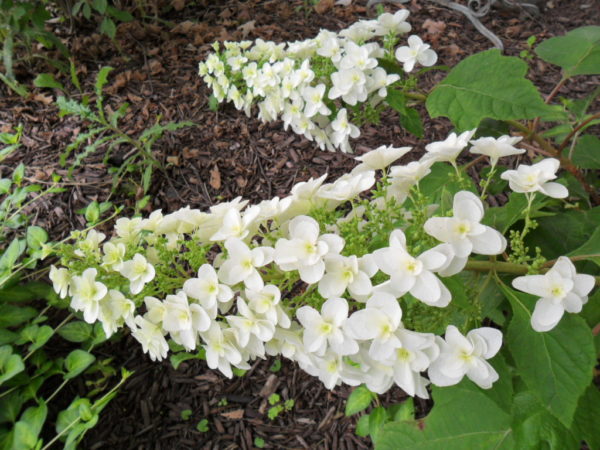
Now approaching three feet tall and nearly as wide, Pee Wee is quickly reaching the limits of its mature dimensions, about four by four. Last year it graced me with but one full-sized blossom, and a stunted side bloom, but this year it sports five lovely flowers. These are composed of two types – a larger, sterile, four-petaled white blossom, and an under-raft of miniscule fuzzy blooms, where the pollen resides. In time it should support many more bloomheads. Under the eaves of the birch branches which sweep the ground, Pee Wee is one of a “second line” of defense against the sun for my shade garden. Once mature, these will prevent even the slanting early morning sun from intruding on my sleepy shade-lovers.
Just a few yards away is Snowflake, an absolutely stunning oakleaf hydrangea with huge panicle inflorescences, each sporting dozens of mini flowers (“inflorescence” is plant-speak for blossom; a “panicle” blossom is one with smaller flowers on mini pedicel stems, radiating from a central stalk). These conical bloomheads are immense, extending a good fourteen inches, covered in masses of triple-layered white and palest green blossoms. For now, these are so heavy as to bend the tender branches of the plant, but as Snowflake matures to its full size of eight-by-eight feet, this will become less of an issue.

Both Pee Wee and Snowflake have bloomheads that are somewhat aerial, meaning their individual parts are slightly separated from each other, with spaces between them. Queen of Hearts, on the other hand, has overlapping small blossoms, making each bloomhead look like so much armor plating. Brilliant white as it opens, when it matures, this color will fade to dusky pink, or at least, that’s what I’m told. This is Queen of Hearts’ first season here, so we’ll just have to wait and see if this is fact, or another hydrangea myth.

Annabelle is my only arborescens hydrangea, which definitely does bloom on new wood! I know that because Annabelle dies back, almost to the soil, every autumn, after providing a showy burst of golden foliage. In spring its growth rate is prodigious, with medium green tender shoots that are soon revealing baseball-sized, round puffballs of blossom, creamy white at first, then turning slightly green. Last year she offered eight blooms, this year we’re up to twice that number and still counting. If cut at the right stage, these preserve beautifully and retain a bit of their green tint in dried arrangements.

Another early summer bloomer is butterfly weed, Asclepius tuberosa. As the name implies, these are a magnet for butterflies, including the royal orange-and-black Monarch butterfly, which lays its eggs exclusively on Asclepius varieties. Mine are a bright yellow in color, but there are many other options (I also have a small stand of self-sowed native milkweed, pinky-white in color, and deeper pink cultivar I just purchased this year, trying to make up for the former fallow field habitat behind me that is now a housing development). Planted as bareroot stock in 2020 (alongside a purple-and-white variety which never came up), they struggled through their first year, but are now well established, with rafts of small golden blossoms arranged in slightly raised ovals across the breadth of the plant. Other pollinators love them, too, and butterfly weed is one of the few members of my garden which can entice the increasingly elusive honeybee to the yard.
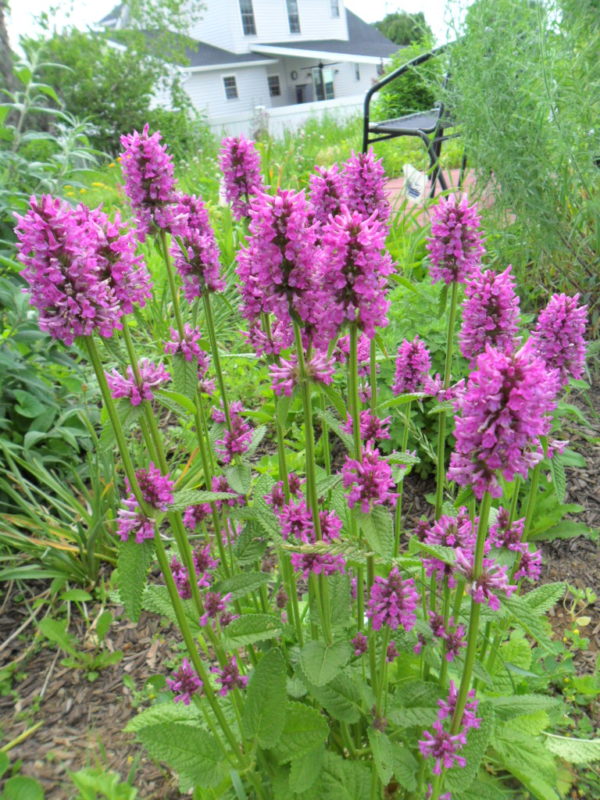
A new arrival this year, also popular with the nectar-and-pollen set, is Betony. With a flower similar to salvia, Betony forms a bushy mass from which extend long spikes of sturdy stems, clustered near the top with relatively small sections of tiny blossoms in pink to deepest purple. The overall effect is of a fireplace poker. I don’t believe I’ve ever seen this plant without at least one pollinator attached; black swallowtail butterflies seem to prize it highly.
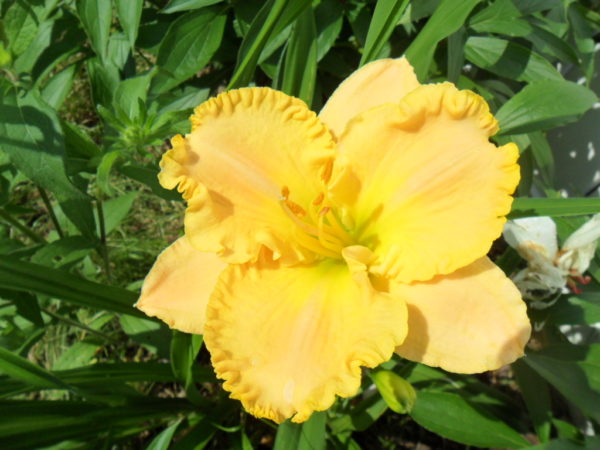
By this time last year I was awash in daylilies, but so far this season, only one has bloomed, the frill-edged, pale butterscotch Collier. I have two of these, one in the east bed, and one in the west – I was startled to note that they began blooming within a day of each other, a remarkable example of plant species coordination. The rest, more than forty varieties, are all sending up heavy-laden scapes, promising a prolific bloom period starting in a few weeks. Some, in their third year here, are so vigorous as to suggest that division this fall might be advisable.

We may be pressing “pause” on the daylilies, but the earlier Asiatic lilies, however, are in full swing! “Forever Susan” is my all-time favorite, with dramatic purple-black midribs and deep orange margins. Although I have several of these scattered across the garden, there is a large planting just outside the laundry room door, and as with Collier, these all popped on the same day. Unlike daylilies, which open and close in a single 24-hour period, Asiatics maintain their blossoms for up to a week, depending on weather conditions, affording an extended timeframe to enjoy the bloom.

Their stunning tones are augmented this year by a mixed bag of rudbeckias, daisy-like flowers which come in a range of tones from yellow through orange and brown. These are not true perennials, but rather freely self-sowing annuals, which cross-pollinate readily, providing interesting variations of their color palette season to season. Some remain solid, others are banded, and there are even a few mutants with striated colors across their petals.
Last year I had only about a half dozen or so of these beauties in the Forever Susan bed, which flopped in wet weather and had to be staked to keep them presentable. But this year their progeny has come back with a vengeance and, interspersed with fleabane, native aster and mullein, has woven a thick mass of vegetation which not only prevents the emergence of weeds, but should act to support and reinforce each member against unsightly sagging. Their complementary colors both highlight and emphasize this bed’s overall “fire tone” vibe, and the rudbeckia will go on to brighten this area for weeks after the Asiatics have faded.
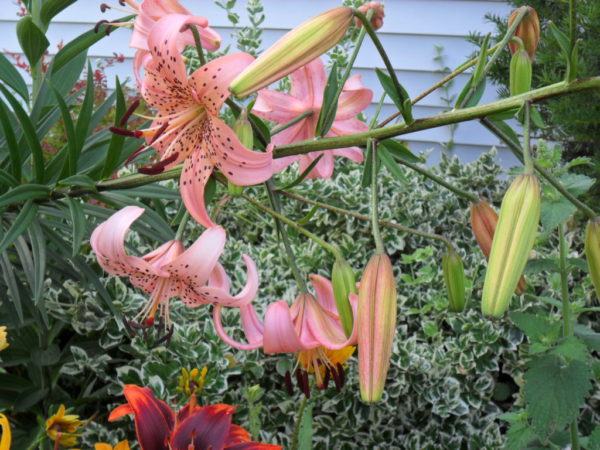
Just as I write, a second Asiatic lily, Pink Giant, is beginning to unfurl. Aptly named, this stunner stands a good nine feet, with the top yard or so covered in layers of buds that open to reveal medium-pink blossoms speckled with maroon-brown spots. I counted 26 buds on the larger of the two, which should be in bloom for at least three weeks. And after three years of waiting, African Queen is finally going to bloom! It’s been so long, I had to google the plant to remind myself what I’ll be seeing: caramel-gold petals with a purplish blush on the outside, and thick cinnamon anthers.

Sundrops are an antique “pass-along plant” that was gifted to me by my Aunt several years ago. A small clump has quickly spread into a sizeable drift of bright, lemon-yellow blooms, with buds that show red-orange before they open. Along with a wild coreopsis that self-sowed three years ago, and several stands of amber-gold Zagreb and pale-yellow Moonbeam coreopsis, these add pops of color throughout the still-predominantly green landscape.
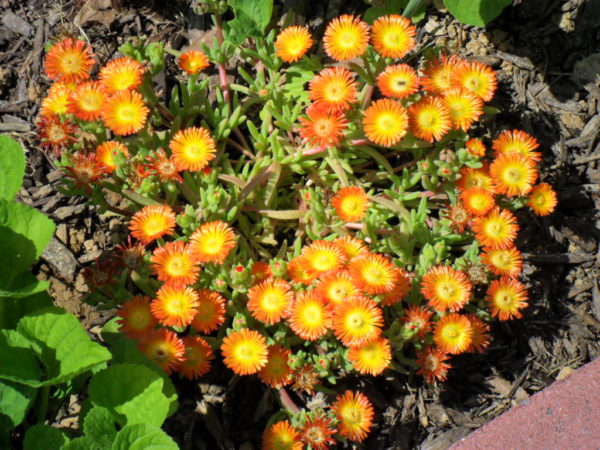
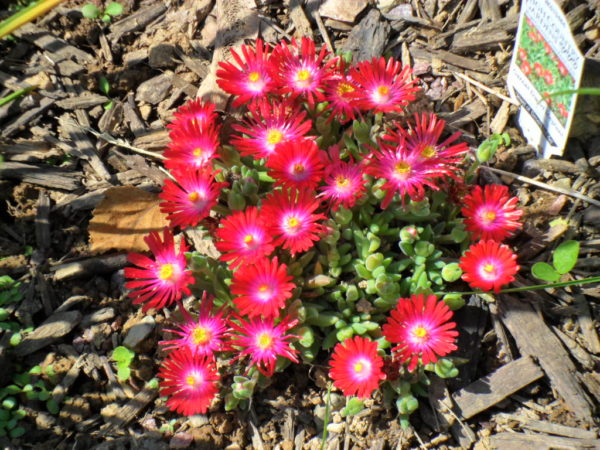
Another new favorite, still rather small but already spreading, are the delospermas, commonly called ice plants. These succulent groundcovers, just 1-3” high, are very drought tolerant, making them a perfect choice for edging the oval bed atop the full-sun, clay-soil sandmound. I have planted a caramel-orange variety with bright gold centers, and a vivid fuchsia with a pale pink-white eye dotted with yellow. A third variety, with bronze-red petals centered in bright lavender, has yet to bloom for me, but is filling in its space very nicely.

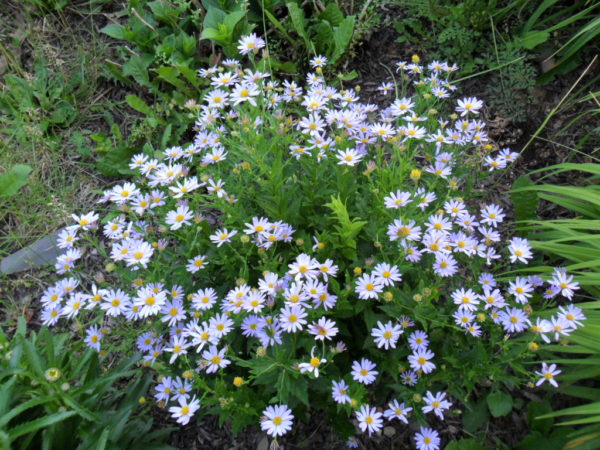
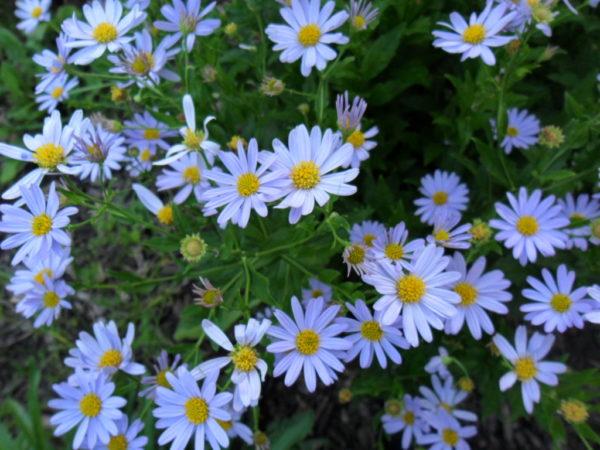
Two more reliable performers are the Shasta Daisy and Blue Daisy. I have a pair of Shastas, on opposite ends of the main planting bed; in late June their buds are just beginning to open, showing buttermilk yellow at first, then maturing to bright white with yellow centers. Blue Daisy, actually an aster, is a milky pale blue with a small goldenrod center; I have three scattered across the garden. Both will provide some degree of rebloom if deadheaded.
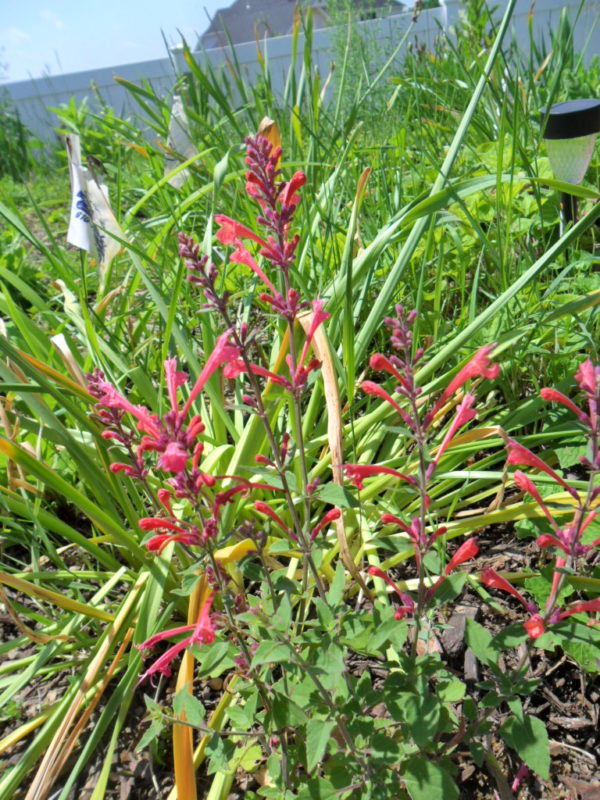
I have a love-hate relationship with Agastache: I love it, but it seems to hate me! Try as I might, I cannot seem to get this perennial to flourish and return. Also known as hummingbird mint, it attracts not only these diminutive avians, but any number of pollinators. It comes in a wide range of colors, pale pink through deep violet, with bugle-shaped flowers opening sequentially, bottom to top, on tall willowy stems. Due to my former failures, I had determined never to try it again. But hope springs eternal, and when I saw a new variety in coral-puce available by mail order late last winter, and on sale to boot, I broke down and bought it. Mail order is typically not a great option for plants, which don’t really enjoy the journey; these arrived intact and healthy, but rather small. They are in full bloom now, stationed on either side of the short path to the sandmound seating area, but goddess only knows if they’ll return.
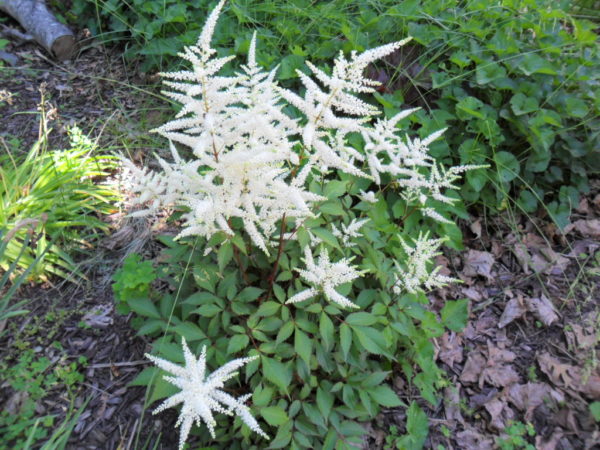
Astilbe is another old friend, a shrublike mass topped with spires of delicate fuzzy flowers massed in panicles, in shades of white to burgundy and lavender. I have three creamy white plants, a hot pink variety, and a serene mauve specimen. The hot pink also has reddish foliage as it emerges, and will provide lovely autumn color, with leaves of burnished gold lined with red-orange. It has an additional advantage in that it blooms later than the others, and is just beginning to bud now, while its brethren are faded and requiring some clean-up action.
I have to also take note of a cornflower I raised from seed last year, which I thought was an annual, but which overwintered (remaining almost evergreen) and has come back this season like gangbusters. The aptly named “Black Gem” sports silver-grey foliage and deep maroon flowers that are a unique color in my garden. Almost black, they really stand out against the leaf mass. The plant has been in bloom for almost a month already, with no sign of slowing down, making it a great addition to the bed by the kitchen door stoop, which is dominated by spring bulbs and ephemerals, and has relatively little summer color.
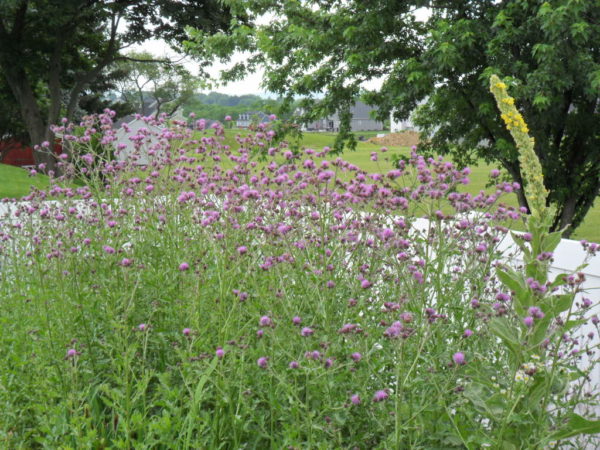
There’s just one wildflower in bloom right now (though some Queen Anne’s Lace are champing at the bit!): that’s thistle, though don’t ask me which one! There are so many thistles, all so similar, that I’ve found it impossible to identify exactly which variety has invaded my garden. I do try to keep up with it, but it’s a thankless and endless task – thistles propagate, not just by seed, but by underground rhizomes which can extend a yard from a parent plant until they come up for air again. Once established, you’re never truly rid of them.


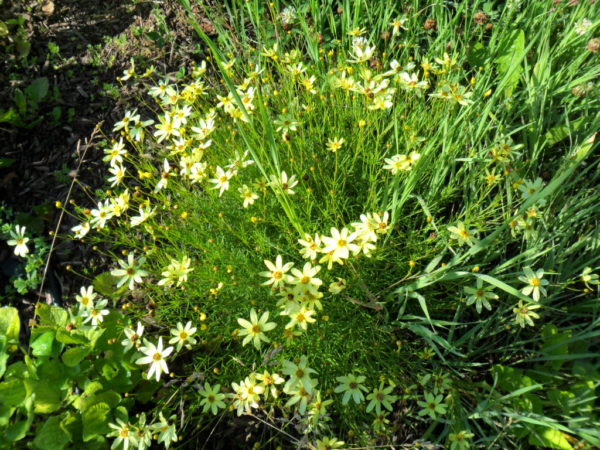
But it’s not all bad; thistle’s deep tap roots bring up nutrients from the subsoil to enrich the topsoil, and help to break up heavy clay into lighter soils more amenable to other plants. And they have a rather attractive blossom, with masses of small, fuzzy flowers in medium purple. They are an important food source for pollinators, and goldfinches simply adore their seeds. My intention had been to leave just a portion on the steep south slope of the sandmound for their colony, but I must admit, they have gotten rather out of hand, dotted here and there throughout the garden. Well, you can’t win them all!

Another theme of 2022 seems to be mullein. This biennial giant can grow to 9 or 10 feet, with layers of large grey-green foliage, small-stemmed where they connect to the trunk, but expanding into large flat ovals resembling oars, then tapering to a tall stem tipped with multiple small yellow blossoms. These open randomly, a few at a time, giving rise to the common name of “witches’ candle”; they really do look like flickering candlelight in the dusky summer evening, and they are just beginning to blossom, scattered across the garden.

And I can’t end this edition without a nod to Autumn Fern. Most of the color has bloomed out in the shade garden with the passage of spring into summer, which is why plants with variegated foliage are always a good investment for these areas. Autumn Fern is unique in that the new fronds, when they emerge, and until they have grown quite large, are at first a delicate shade of bronzy-copper. I haven’t yet pinpointed the stage at which this mutates into a rich yellowish green, but I’m keeping my eye on it!

The bee balm has been sprayed (all 500 buds of it!) and is just beginning to break, the daylily scapes are pushing skyward, heliopsis is starting to open, echinacea begins to expand its pincushion blooms – it won’t be long now, until summer’s brilliance is revealed!


5 comments, add yours.
Emma Esperanza Acosta Vásquez
nice garden thanks for sharing
lindo su jardín gracias por compartir
Danielle
I can’t decide which I like better, your astrological insights or your garden. Thank you so much for sharing both. It was the highlight of my morning!
edna
Incredible to see how far you have come with this garden paradise. I am just in awe of your accomplishments and green with envy. We are now in a stage 2 drought here and everything is brown. I’m living vicariously through your photos.
Laurien
Enjoyed your photos so much, Alex! The combination of the Forever Susan lilies and the rudbeckia is stunning. Also enjoyed your Collier day lily and I am a big fan of astilbes. Would like to get my hands on some purple cornflower seeds–will have to look around. Regret now that I uprooted my mullein considering it a weed! Thanks for the gardening inspiration. Enjoy the rest of the season!
Alexa
Spectacular show! What a treat for the eyes. Thank you!